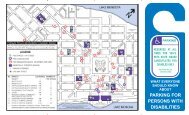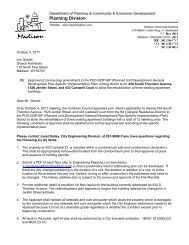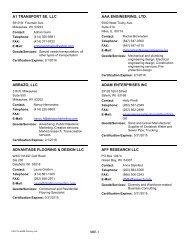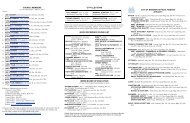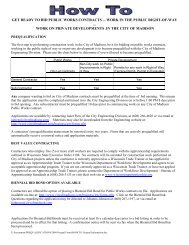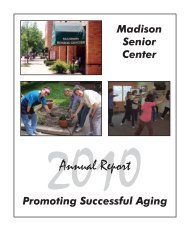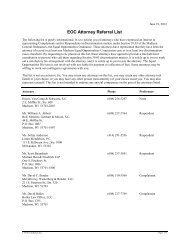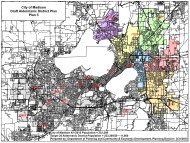Madison Cultural Plan 2011 - City of Madison, Wisconsin
Madison Cultural Plan 2011 - City of Madison, Wisconsin
Madison Cultural Plan 2011 - City of Madison, Wisconsin
Create successful ePaper yourself
Turn your PDF publications into a flip-book with our unique Google optimized e-Paper software.
• Unmet technical assistance and organizational development needs;<br />
• Higher costs associated with absence <strong>of</strong> joint purchasing (including health<br />
insurance), joint marketing, fund development, audience development, and<br />
shared use <strong>of</strong> spaces and equipment;<br />
• Absence <strong>of</strong> leadership development specific to arts and cultural stewardship<br />
and concomitant absence <strong>of</strong> diversity and breadth within the boards <strong>of</strong> local<br />
arts and cultural institutions; and<br />
• Diminished private sector participation in nonpr<strong>of</strong>it funding and stewardship.<br />
<strong>Madison</strong> lacks a heart that works to pump ideas and opportunities throughout the<br />
community <strong>of</strong> creative investors, producers, and consumers. The creative sector<br />
yearns for a convening entity where it can gather to sustain its work and craft its<br />
own future. This need has been present for over a decade and was formally<br />
articulated by those participating in the 2003 Call to Action Arts Summit.<br />
Individuals in <strong>Madison</strong>’s creative sector called with near unanimity for a creative<br />
commons, uniting creative sector participants, including its workers, funders, and<br />
consumers, in common cause. By establishing a public/private/creative sector<br />
partnership entity, <strong>Madison</strong> could catalyze exciting collaborations and events,<br />
bolster creative output, grow and equalize citizen access, strengthen volunteerism<br />
and stewardship, give the creative sector voice in civic affairs, increase fiscal<br />
efficiency, diversify earned and donated resources, and ignite broader citizen<br />
participation in <strong>Madison</strong>’s creative life.<br />
This need is not unique to <strong>Madison</strong>. Approximately 35 <strong>Wisconsin</strong> communities, both<br />
large and small, have local arts or cultural agencies that focus on connecting the<br />
field, representing its interests, and promoting public access to arts and cultural<br />
activities. Nationally, they are commonly present in communities with strong<br />
creative pr<strong>of</strong>iles. See Appendix C and Recommendations 6, 7, and 49.<br />
IIIA.1. ELECTRONIC INFORMATION SHARING<br />
A variety <strong>of</strong> local databases (both online and privately held) gather information<br />
about arts and cultural entities, artists, genres, and interests but none is<br />
comprehensive. Few have sufficient functionality, participation, or visibility to be<br />
useful to the public. There are very real options for enhancing, merging, and<br />
strengthening any number <strong>of</strong> them (Portal <strong>Wisconsin</strong>, Madstage.com, <strong>Madison</strong><br />
<strong>Madison</strong> <strong>Cultural</strong> <strong>Plan</strong> Findings<br />
26




